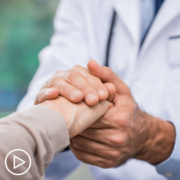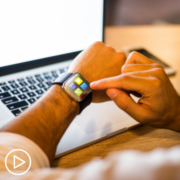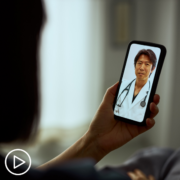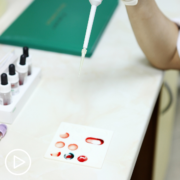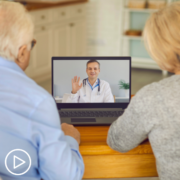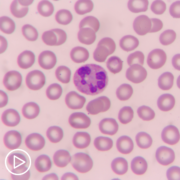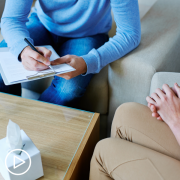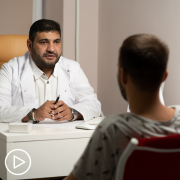Though Robyn Rourick is a scientist by training and works for a biotechnology company, she took a mind-body approach to her myeloproliferative neoplasm (MPN) journey. The time that passed between Robyn’s initial MPN diagnosis and when she finally needed treatment was incredibly – and nearly shockingly – long. She was diagnosed with essential thrombocythemia (ET) 26 years after elevated platelets were shown on a routine blood test. After she saw a hematologist, they performed a bone marrow biopsy and concluded she didn’t have myelofibrosis and received the ET diagnosis. Robyn recalls of the time of her diagnosis, “I didn’t know about myeloproliferative disorders. Not many people did at the time. Nobody mentioned that I could potentially have an MPN.”
Robyn’s blood levels were monitored over the years, and her platelets started to decrease. Though she didn’t realize at the time, her platelets were decreasing because her bone marrow was becoming more fibrotic. She was also tested for the early gene mutations (JAK2) that were discovered as more MPN research occurred but tested negative . She later switched to another hematologist who was very tuned into the gene connections. He looked at Robyn’s medical data comprehensively and was extremely attentive to any minor changes. As her blastocytes began shifting, he urged her to go see MPN specialist Dr. Gotlib. Dr. Gotlib did further analyses and classified her as having myelofibrosis, noting that when she was diagnosed with ET that her original healthcare team also couldn’t have ruled out pre-fibrotic myelofibrosis at that time. Fortunately, Dr. Gotlib stated if he had diagnosed her with her original blood test 26 years prior, he would have recommended to simply watch and wait while monitoring Robyn’s blood levels on a regular basis.
Although Robyn felt healthy and had no symptoms besides an enlarged spleen, as Dr. Gotlib dug deeper into her genetic profile, he found a unique mutation that suggested she was at risk for an escalation into acute myeloid leukemia mutation. He recommended Robyn for an immediate allogeneic stem cell transplant for her MPN treatment.
Robyn then learned that graft-versus-host disease (GVHD) was a major concern for the transplant process, which can be debilitating. So she began to seek patient advocacy resources to inform her MPN journey. “I felt desperate and wanted to meet people who had myelofibrosis who successfully came through transplant. I didn’t want to just talk to a transplant person with a different disease.” Robyn went through some patient connection programs – including Be the Match, Caring Connections Program, and Patient Power – and was able to meet a few people and became quite close with one patient.
She learned that even though transplant will cure your disease, doctors don’t always elaborate with patients on the potential for a compromised lifestyle due to graft-versus-host disease. Sometimes patients will come through transplant in worse condition than before the treatment. Robyn had major fears about going through transplant and being able to work and do her extracurricular activities post-transplant. “I felt like I was going to be a letdown for my family and colleagues and didn’t tell my work until I was preparing to go out on leave, which in retrospect was silly.” After telling her manager, Robyn was given complete support, and realized she could have avoided carrying so much anxiety.
“For me, self-education and advocacy are important to enable yourself to have conversations about what’s possible in terms of your treatment. You don’t have to develop an in-depth understanding, but enough to have the ability to be conversational. If you’re proposed a certain pathway, it’s good to know enough to ask why. And if you’ve done some research on your own, then you can ask why not an alternate treatment approach. I think it’s really important to have some knowledge, because it builds your confidence to be able to move forward with what’s being proposed.”
“Give it time, allow yourself to digest the information, have conversations about it, and develop your own understanding. At first, I was very closed about my diagnosis. I told my immediate family, and I told one very close friend who had gone through autologous transplant. The more that I began to talk about it and the more that I included people in the story, the easier my journey became.” Robyn also saw a cancer therapist who made some really good points to her. “She told me that ‘we’re all going to die of something, but most of us don’t know what that really looks like.’” In Robyn’s case, she had the opportunity to learn more about her disease, guide it, and direct her journey. And that opened up a whole new perspective.
The cancer therapist walked Robyn through some exercises: “What is it you’re afraid of? What do you have control over? Allowing yourself to gain control over some things will build your confidence that you can do this.” Robyn also encourages other patients to engage their network of friends and family and realize that it’s okay to depend on people. It’s not your fault that you have this diagnosis. Getting over the apprehension of telling people about your diagnosis and embracing help from others are key pieces of advice.
Robyn views patient empowerment as essential to the patient journey. She discovered Patient Empowerment Network (PEN) through another patient advocacy website and felt it brought her MPN patient experience full circle in terms of learning what’s available. “As I’m learning more about PEN, I’m just dazzled by the different forums they have to enable knowledge transfer, support systems, and advocacy.”
Read the second part of Robyn’s MPN journey here…


